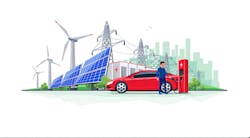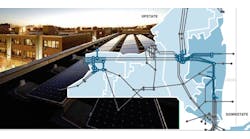Federal Energy Regulatory Commission (FERC) Order No. 2222-A, released March 18, continues efforts by US regulators to remove barriers for aggregated distributed energy resources (DERs) in wholesale markets. And it may unlock new revenue streams for microgrids.
That’s the word from Norman Bay, former chairman of FERC, who called the order “exciting to see.” Bay is now head of the energy regulatory and enforcement group for the law firm Willkie Farr & Gallagher.
The order follows FERC Order 2222, issued Sept. 18, which paves the way for aggregated DERs to compete on the same footing as traditional power plants and other grid resources in wholesale markets.
The commission’s new decision focuses on the demand response “opt-out,” which blocks grid operators from accepting offers from aggregated demand response in states where the practice is not allowed.
As a result of the March 18 order, the opt-out will no longer apply.
FERC argued that the opt-out goes against the goals of Order No. 2222 because it would reduce the diversity of aggregated DERs.
As part of the order, FERC also issued a notice of inquiry asking for comments on any possible burdens on states caused by the decision. More specifically, the agency seeks input on what the impact will be if states lose their ability to prevent demand response resources from participating in organized wholesale markets, said Ben Schwartz, policy manager for Clean Coalition.
“In Order 2222-A, FERC demonstrates the commitment it made in Order 2222 to open up wholesale markets to DER, going as far as to consider changing the regulation issued in 2008 related to demand response resources,” Schwartz said.
Win for microgrids
“Order 2222-A creates another opportunity seemingly tailored for microgrids through asset-based demand response,” said Schwartz. Asset-based demand response uses an on-site energy source, such as a microgrid, as a means to participate in demand response. When a utility calls for demand response, the customer will take power from the generation in its microgrid, rather than the grid.
Schwartz focused on the benefits of solar microgrids, but any microgrid can provide asset-based demand response. As exclusively behind-the-meter resources, solar microgrids can continue to meet their load while isolating from the distribution grid when it is most beneficial for the grid and get paid for it, he said.
FERC 2222-A will apply after it is published in the Federal Register, 60 days after the decision date. Once it is adopted, the rule will allow microgrids isolating for demand response to take part in a larger range of programs that would include possibly aggregating with other DERs and participating in wholesale markets.
It’s also possible that a community microgrid might be able to bid into a wholesale market on its own. “Order 2222-A provides flexibility, allowing community microgrids of all sizes to benefit from islanding capabilities,” said Schwartz.
Origin of FERC 2222-A
Order 2222-A is a rehearing of Order 2222, which is common in FERC cases, said Will Keyser, a partner in Steptoe’s Energy Group.
A number of stakeholders requested the rehearing on numerous issues. DER groups and utilities continue to seek changes and clarifications related to Order 2222, he said.
“In some cases, people ask for clarification on various issues. FERC intentionally created a pretty broad program and left it to individual regional transmission operators (RTOs) to implement. There are not a lot of specific requirements, but broader requirements to be worked out in the stakeholder process,” Keyser said. The RTOs and independent system operators (ISOs) have not yet submitted filings on how they plan to implement the order.
Learn about how microgrids save money and earn revenue May 18 and May 20 at Microgrid 2021: The World Awakens to Microgrids. Attendance is free for the virtual event if you register in advance.
In general, stakeholders are interested in the size and geographic reach of DER aggregations. For example, “How broad will they be geographically and will they be limited to certain MWh? Will they be confined to a single node?” said Keyser.
Punch behind order
By DCStockPhotography/Shutterstock.com
Part of the punch behind Orders 2222 and 2222-A is that together they will establish market participation models for the aggregation of resources. Those resources include generators, energy storage, electric vehicles, energy efficiency and other energy systems common in microgrids, said Mike Berlinski, director of emerging technology at Customized Energy Solutions.
To comply with Order 2222, closer coordination between distribution utilities and ISOs/RTOs will be needed, Berlinski added. “This will help more complex resources like heterogeneous aggregations and microgrids move forward,” he said.
When the much-anticipated FERC Order 2222 was issued, it helped move the industry away from a patchwork of rules about DER market participation, said Kenneth Schisler, CPower’s vice president of regulatory affairs.
Together, FERC Orders 2222 and 2222-A require that wholesale markets allow all of these DERs to participate in markets under a unified set of rules so the resources can be aggregated and optimized. This has important implications.
“This ability to combine different types of resources in aggregations will be helpful in a number of ways, least of which is offering a simpler way to realize benefits of assets like microgrids. It will also help project financing and allow organizations to fit solutions to their needs, rather than design them to meet a patchwork of different state program rules,” Schisler said.
Overall, the rulings allow for continued innovation and a democratization of the grid.
“With the policy changes underway, we are not only witnessing a ‘democratization’ of the grid so that consumers can meet their own needs, but also encouraging an additional competition in the marketplace that helps promote investment and keeps costs down,” Schisler said.
Track news about microgrid policy. Subscribe to the free Microgrid Knowledge Newsletter.








